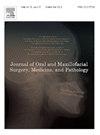Evaluation of radiation planning in the development of acute radiation oral mucositis in head and neck cancer patients: A case series
IF 0.4
Q4 DENTISTRY, ORAL SURGERY & MEDICINE
Journal of Oral and Maxillofacial Surgery Medicine and Pathology
Pub Date : 2024-08-08
DOI:10.1016/j.ajoms.2024.08.006
引用次数: 0
Abstract
Background
Radiation planning is a way to optimize dose at the radiation target volume and reduce the risk of radiotherapy side effects in the management of Head and Neck Cancer (HNC) obtained from the Treatment Planning System (TPS) process. It shows various distributions of radiation doses and can predict the location of toxicity that appears in the oral cavity. The purpose of this report was to describe the isodose curve as part of TPS to predict the severity of oral mucositis.
Case series presentation
Four patients with HNC aged 40–60 years, complained of canker sores and taste loss during radiotherapy for 3–6 weeks with exposure to 30–50 Gray radiation doses. Intraoral examination in all cases found ulceration covered by a yellowish-white pseudomembranous, surrounded by an erythematous erosive area. Three cases also found yellowish-white plaques that could be wiped leaving erythema areas. The diagnosis of oral mucositis grade 2–4 on the Radiation Therapy Oncology Group (RTOG) scale, oral candidiasis, and dysgeusia were made. Various distributions of radiation doses received in the oral cavity were as predicted at TPS and according to the location and severity of oral mucositis that occurs in patients.
Case management
All patients were given 0.025 % hyaluronic acid mouthwash, multivitamins, and instructions for maintaining oral hygiene and a balanced diet. Three patients with oral candidiasis were also given nystatin oral suspension 100.000 IU
Conclusion
Managing oral mucositis in radiotherapy for HNC patients remains challenging. Utilizing TPS results during radiation planning enables the prediction and prevention of oral mucositis.
评价放疗计划在头颈癌患者急性放射性口腔黏膜炎发展中的作用:一个病例系列
背景放疗计划是头颈癌(HNC)治疗过程中通过治疗计划系统(TPS)优化靶量剂量和降低放疗副作用风险的一种方法。它显示了辐射剂量的不同分布,可以预测口腔中出现的毒性的位置。本报告的目的是描述等剂量曲线作为TPS的一部分,以预测口腔黏膜炎的严重程度。病例系列表现:4例年龄40-60岁的HNC患者,在放射治疗3-6周,暴露于30-50剂量的灰色辐射期间,主诉口腔溃疡和味觉丧失。所有病例口内检查均发现溃疡被黄白色假膜覆盖,周围有红斑糜烂区。三个病例还发现了黄白色斑块,可以擦去,留下红斑区域。根据放射治疗肿瘤组(RTOG)评分,诊断为口腔黏膜炎2-4级、口腔念珠菌病、吞咽困难。口腔内接受的辐射剂量的各种分布与TPS的预测一致,并根据患者发生的口腔粘膜炎的位置和严重程度进行预测。病例管理:所有患者均给予0.025%透明质酸漱口水、多种维生素,并指导保持口腔卫生和均衡饮食。3例口腔念珠菌病患者同时给予制霉菌素口服混悬液10万iu。结论HNC患者放射治疗口腔黏膜炎仍具有挑战性。在放疗计划中利用TPS结果可以预测和预防口腔黏膜炎。
本文章由计算机程序翻译,如有差异,请以英文原文为准。
求助全文
约1分钟内获得全文
求助全文
来源期刊

Journal of Oral and Maxillofacial Surgery Medicine and Pathology
DENTISTRY, ORAL SURGERY & MEDICINE-
CiteScore
0.80
自引率
0.00%
发文量
129
审稿时长
83 days
 求助内容:
求助内容: 应助结果提醒方式:
应助结果提醒方式:


